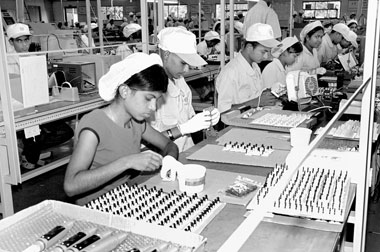Productivity with existing people, existing equipment and space
By Thilak PUSHPAKUMARA
TPM is a corporate strategy which can transform a manufacturing
organization with the development of existing employees and existing
equipment. Initially TPM stood for Total Productive Maintenance and
later 'P'would denote Perfect or Production, while 'M' includes
Management besides Maintenance. Today TPM stands for Total Profit
Management.
 TPM is not a maintenance tool and it combines the best features of
productive and predictive maintenance with innovative management
strategies and total employee involvement. TPM is not a maintenance tool and it combines the best features of
productive and predictive maintenance with innovative management
strategies and total employee involvement.
The eight pillars of TPM cover almost all functions in a
manufacturing environment.
Why is TPM required now?
Today, the manufacturing environment becomes even more severe and
total elimination of waste is required for the survival of the
manufacturing organisation. Therefore, waste generated due to the
failure of facilities which has incurred huge investment and waste such
as defective products should be absolutely eliminated.
The small lot production of various kinds of products and shortening
of production lead time has been strongly required to meet diversified
customer needs.
TPM to reduce the 8 major equipment losses to zero has been
recognised as necessary for corporate survival. The change over time
which is more vital in lead time reduction is included in the 8 major
losses.
Requirements of product quality become even more stringent and not
even one defective product should be allowed.
Quality Assured Perfect Line (SAPL) with the delivery of total
quantity is now taken for granted.
Avoidance of 3Ds (Dirty, Difficult and Dangerous) at the workplace is
very important to challenge 'zero accidents'.
Accident is a cost and also it reduces employee preference for happy
employment. Employee safety, equipment safety and product safety decides
the future of any business and survival.
5S, the foundation of TPM will create a work friendly environment
where the Safety Health and Environment pillar of TPM builds a Safety
Assured Perfect Line (SAPL)and an Environment Assured Perfect Line (EAPL).
"Protect the environment, the environment protects people."
Other than the 8 major equipment losses there are another 8 losses
which is addressed under TPM - 5 major losses in management which
effects labour productivity and 3 major losses which directly impact the
manufacturing cost.
We call it cost loss. It is Energy, Consumables and Yield loss.
Accordingly, the introduction of TPM to reduce the 16 major losses to
zero in the manufacturing process and challenging zero accident for
corporate survival is required. Once these 16 losses are converted into
cost, you could realize the importance of TPM for your business. The
loss cost matrix will be an eye opener.
How can we start TPM?
Japan Institute of Plant Maintenance (JIPM) has introduced 12 steps
for successful TPM implementation. It starts with an official
declaration by the CEO/MD that the company is introducing TPM as a
strategic approach for survival. Then awareness begins across the
organisation "Introductory education and campaign of TPM" starting from
top management.
The content and the duration will differ from category to category.
The third step is establishing a TPM promoting organisation and a
pilot model. From a matrix organisation which is composed of a
horizontal organisation like a TPM promotion committee or the project
teams and a vertical organisation, which is the regular company
organisation is combined, and also to form the all -employees'
participation type of organisation consisting of small overlapping
groups.
Basic policies are then set with targets for TPM and creation of a
master plan for developing TPM.
Once the 5th step is completed, you are ready for TPM kick off and
gradually move to other steps which address all activities of the eight
pillars in detail.
Development of TPM in Sri Lanka
TPM was successfully implemented at Unilever Sri Lanka and it was
recognised by JIPM.
Unilever is the only TPM certified company in Sri Lanka.
A few leading companies are moving to TPM. Ceylon Biscuits Limited,
is introducing TPM by following the JIPM 12 steps.
The apparel sector has also realised the importance of TPM and some
organisations have introduced TPM as a supportive tool for lean
manufacturing, and not as the main initiative.
TPM education is now spreading in Sri Lanka. The TPM Practitioner
Certificate Program conducted by JASTECA has become very popular among
leading manufacturing organisations such as CBL, MAS, Brandix , Omega
line, Nestle, Fonterra, CCS, Hemas, Kelani Cables, Ceylon Pencil Co,
Dankotuwa Porcelain, Flintec Transducers, Ole Springs. 56 TPM
practitioners have been certified and another 18 will be certified by
the end of August.
TPM has become popular because it gives both tangible and intangible
results. Attitude transformation and skill enhancement of employees are
considered as the major intangible benefit which supports building a
capable organisation and changing the corporate culture.
The writer is a JIPM accredited TPM Instructor and CEO, Institute of
Lean Management Pvt., Ltd.
|

